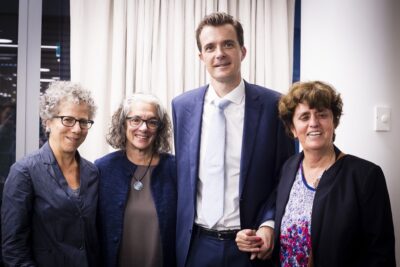Article updated
This article has been updated since it was first published on July 26, 2022. The most recent update was added on August 15, 2022. Read the updates for this article.

Recently I had the opportunity to ask an audience the first words that came to mind when I said “law in the digital accessibility space.” I heard what I often hear: “threatening” “ambiguous” “confusing.”
Yet I heard something else too. I heard reference to the law in the digital space as a “powerful enabler”and a “door-opener.”
Today is the 32d anniversary of the Americans with Disabilities Act. It’s long past time to shift from the fear-climate of the first set of words to the expansive possibilities of the second set. After all, the ADA has applied to the digital space for decades.
[The photo illustrating this post was taken by disability movement photographer Tom Olin. It shows three disabled people crawling up the steps of the capitol as part of a protest to get the ADA passed. There is a Black woman in foreground and a white man in background. They are two of dozens who left their wheelchairs and mobility devices behind for a visceral display of what the world was like before the sweeping civil rights law that is the ADA passed. The image is a reminder that the ADA passed because of activism, organizing and advocacy by disabled people and disability organizations. Read more about the Capitol Crawl.]
This article has the following sections:
The ADA has embraced inclusive communications (including digital!) since the beginning
The ADA is a law, and it is also a dream. A law with requirements designed to fulfill a dream of full inclusion for people with disabilities in all aspects of society. The original language of the Americans with Disabilities Act is expansive enough to cover methods of communication not yet dreamt of when a Republican president signed the bill. (yes — there was a time when civil rights were bi-partisan!)
The ADA has many definitions of discrimination. Almost all of them are key to digital accessibility, including broad language focused on the rights of people with disabilities to participate in public and private sector offerings, avoid barriers to employment, and enjoy the “benefits” of many aspects of society.
One part of the ADA that is particularly helpful in the digital space defines discrimination as:
a failure to take such steps as may be necessary to ensure that no individual with a disability is excluded, denied services, segregated or otherwise treated differently than other individuals because of the absence of auxiliary aids and services, unless the entity can demonstrate that taking such steps would fundamentally alter the nature of the good, service, facility, privilege, advantage, or accommodation being offered or would result in an undue burdenOriginal text of the ADA Section 302(b)(2)(iii)
That odd phrase “auxiliary aids and services?” It was defined in 1990 to include. (“Include” — which means not limited to the list here.)
(A) qualified interpreters or other effective methods of making aurally delivered materials available to individuals with hearing impairments;
(B) qualified readers, taped texts, or other effective methods of making visually delivered materials available to individuals with visual impairments;
(C) acquisition or modification of equipment or devices; and
(D) other similar services and actions.Original text of the ADA Section Section 3 (1.)
There it is — baked right into the original text of the law: What is an accessible website other than a way to make “visually delivered materials available” to blind people? What is a captioned video (anywhere in the digital space) other than an “other effective method of making aurally delivered materials available” to people who are D/deaf and hearing impaired?
For 32 years this text has been the foundation of court opinions, federal agency actions, Structured Negotiation settlements, and individual advocacy by disabled people seeking long-overdue inclusion in the digital space.
Back to top1996-2000: Earliest references to the ADA’s application to the digital world
Here are the two earliest references outside the law itself that I’m aware of:
Letter from DOJ to Senator Tom Harkin re digital accessibility
In 1996 (26 years ago) Senator Tom Harkin wrote to the US Department of Justice with a question. To respond to an inquiry from a constituent, Harking asked for clarification on the “administration’s policy on making Web pages compatible for the disabled.”
The Department’s clarification came from Deval Patrick, then Assistant Attorney General of the Civil Rights Division of the US Department of Justice. My favorite part of his answer to Senator Harkin is this:
Covered entities under the ADA are required to provide effective communication, regardless of whether they generally communicate through print media, audio media, or computerized media such as the Internet. Covered entities that use the Internet for communications regarding their programs, goods, or services must be prepared to offer those communications through accessible means as well. September 9, 1996 letter from DOJ to Senator Harkin
- Read the 1996 letter from Senator Harkin and the DOJ’s response. (I downloaded this document from this DOJ web page.)
Hooks v. OKBridge
Hooks v. OKBridge: In 2000 the US Department of Justice filed a friend of the court (amicus) brief in a case in the federal appeals court. The case was filed by a person with bipolar disorder whose membership from a website that allowed members to play the card game bridge online. The site owner, OKBridge, argued that the Americans with Disabilities Act did not apply to web-only businesses. The DOJ entered the case to explain that
A Commercial Business Providing Services Solely Over The Internet Is Subject To The ADA’s Prohibition Against Discrimination On The Basis Of Disability.DOJ legal brief in Hooks v. OKBridge
and
The ADA’s definition of a “public accommodation” is intentionally broad and is not limited to those entities providing on-site services.DOJ legal brief in Hooks v. OKBridge
There are many gems in the DOJ’s argument to the court including those quoted above. Read the DOJ legal brief in Hooks v. OKBridge
Back to top2000 – 2022: Thanks to the ADA disability rights in the digital space continues to expand
First web accessibility agreement was 22 years ago!
As described in my book, Structured Negotiation, a Winning Alternative to Lawsuits (2d Edition) I have worked to advance digital accessibility through collaboration instead of lawsuits for more than a quarter century. In Structured Negotiation agreements, we don’t argue about legal fine points. There is no court concluding that anyone violated the law, and in our agreements we specifically say that no one is admitting liability or making accusations.
Yet every single settlement my clients, co-counsel and I have negotiated since the first one in 1999 would not have been possible without the Americans with Disabilities Act and related laws based on the sweeping, flexible provisions of that law. The law has provided a foundation for our work in the digital space — from websites and mobile apps, to ATMs, accessible pedestrian signals, point of sale devices and talking prescription labels. By providing a “private right of action” that allows individuals to enforce their rights in court, the ADA also paves the way for a collaborative alternative such as Structured Negotiation.
In 2000 blind advocates, the California Council of the Blind, Linda Dardarian and I negotiated the very first website accessibility agreement in the United States with Bank of America. I wrote about that agreement on its 20th anniversary in 2020. The relationships, trust, and the bank’s good faith — all fostered by the Structured Negotiation process — made that agreement possible. The foundation of the ADA was also critical.
As the audience members reminded me, that agreement was a “door-opener” and “powerful enabler.” We went on to negotiate dozens of digital accessibility agreements, including many on web and mobile accessibility. Negotiated with collaboration, trust, no legal battles, and, in the background, the ADA.
(Read the August 15, 2022 Update at the end of this article to learn what was happening in Australia at the very time we were working on the Bank of America web agreement.)
The ADA continues to support digital accessibility
The ADA continues to support inclusion in the digital accessibility space (though not fast enough). You can read about a lot of those legal advances on this website. A few ways to start include the following:
- The Legal Update page includes short summaries with links to articles about cases, laws, regulations, DOJ actions and Structured Negotiation settlements in the digital accessibility space.
- The Topics Page organizes 350+ articles on this website into various topics, almost all of them related to the digital accessibility space and legal issues.
- The Speaking archives links to talks I’ve given that the organizers have recorded and made public. Many of these are talks about the digital accessibility legal space. (Visit the speaking page on my website if your organization is interested in a talk or training on these issues.)
What’s next?
There are certainly ways to imagine the ADA being clearer on digital accessibility responsibilities. (Just as there is no doubt that regulations about the Web Content Accessibility Guidelines (WCAG) would be helpful.) Yet suggested revisions to the ADA run the risk of making it weaker. This is why I have opposed the so-called Online Accessibility act. And in today’s political climate, I fear any effort to clarify the ADA in the digital space would strip the ADA of some of its provisions.
The ADA has been a powerful enabler of digital inclusion for decades. Let’s stop saying it’s confusing. Let’s stop being afraid of a civil rights law designed for inclusion. Let’s stop letting bad actors in the legal space (including one-line-of-code-overlays and unscrupulous lawyers) create an atmosphere of fear and influence policy.
And most of all, let’s do better and let’s go faster in fulfilling the promise of the ADA in the digital world.
Happy 32d anniversary to the ADA. May you live long and prosper.
Updates to this article
August 15, 2022 Update
Although not about the Americans with Disabilities Act, I’m updating this article to include what many believe to be the “first case in relation to access to websites in the world.” In 2000 Bruce Maguire, a blind man in Australia, lodged two complaints of unlawful disability discrimination against the Sydney Organising Committee for the Olympic Games (SOCOG).
The complaints claimed that the organization’s website was not accessible. The complaints were heard by the (then-named) Human Rights and Equal Opportunity Commission. The Commission found that Mr. Maguire was discriminated against.
The Public Interest Advocacy Centre (PIAC) represented Mr. Maguire and issued a press release about the case. The press release links to the August 3, 2000 Opinion of the Federal Court of Australia in the case of Maguire v Sydney Organising Committee for the Olympic Games. That opinion (in very legalistic language) ruled that the Olympic organizing committee should pay Mr. McGuire for the costs he incurred in pursuing the case.
 Thanks to the person who sent me this information and wished to remain anonymous. Thanks to PIAC for pursuing this case. It’s nice to know that although we were 7,500 miles apart, we were working on early website accessibility legal actions at the very same time.
Thanks to the person who sent me this information and wished to remain anonymous. Thanks to PIAC for pursuing this case. It’s nice to know that although we were 7,500 miles apart, we were working on early website accessibility legal actions at the very same time.
Then, seventeen years later, I had the opportunity to meet with PIAC lawyers during a talk I gave in Sydney Australia organized by Gisele Mesnage of the Digital Gap initiative. The image in this update shows Gisele, Jonathon Hunyor currently CEO of PIAC, Andy Durbach, then Director of the Australian Human Rights Centre, and me at that talk.
As I often say, more proof that accessibility is global!